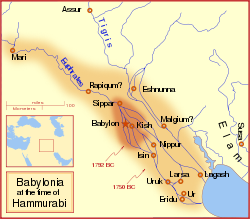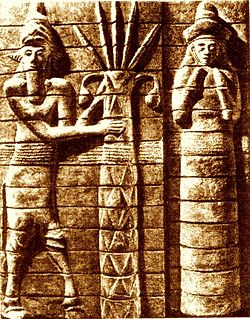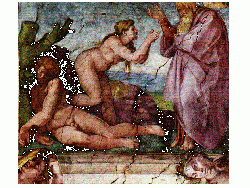Ninhursag
In Sumerian mythology, Ninhursag (NIN.URSAG) was the earth and mother-goddess, one of the major deities of ancient Sumer. She is principally a fertility goddess and the goddess of sacred mountains. Temple hymn sources identify her as the "true and great lady of heaven," and kings of Sumer were "nourished by Ninhursag's milk." She is typically depicted wearing a horned head-dress and tiered skirt, often with bow cases at her shoulders, and not infrequently carries a mace or baton surmounted by an omega motif or a derivation, sometimes accompanied by a lion cub on a leash. She is the tutelary deity to several Sumerian rulers.
One of the oldest of the Mesopotamian gods, Ninhursag both subsumed the characteristics of similar deities like Ki (earth) and was later herself subsumed by them, especially the fertility goddess Inanna/Ishtar. She is known to have had temples at Eridu and Kish, and other locations.
In the myth of Enki and Ninhursag, she heals the major deity Enki of a dreadful disease and gives birth to eight more gods, including Ninti, the "Lady of the Rib." Analysts have seen parallels between this myth and the story of Adam and Eve in the Garden of Eden. In the flood story of Atrahasis, as the "womb-goddess," she is chosen by the other gods to be the creator of humankind. In one creation myth, as Ki (earth), Ninhursag and the sky god An are born together from the primordial sea and become the parents of the other gods.
Names

Ninhursag means literally "Lady of the Mountain," from the Sumerian Nin ("lady") and Ḫursag ("sacred mountain"). She had many august titles, including Ninmah ("Great Queen"); Nintu ("Lady of Birth"); Mama or Mami (Mother); Sister of Enlil; and Belet-Ili (Lady of the Gods). Minor titles applied to her include Ninzinak (Lady of the Embryo); Nindim (Lady Fashioner); Nagarsagak (Carpenter of Insides); Ninbahar (Lady Pottery); Ninmag (Lady Vulva); Ninsigsig (Lady of Silence); Mudkesda (Blood-Stauncher); Amadugbad (Mother Spreading the Knees); Amaududa (Mother Who Gives Birth); Sagzudingirenak (Midwife of the Gods); Ninmenna (Lady of the Diadem).
According to one legend, her name was changed from Ninmah to Ninhursag by her son Ninurta in order to commemorate his creation of the mountains. In one Babylonian investiture ritual, as Ninmenna (Lady of the Diadem), she placed the golden crown on the king in the Eanna temple.
Some take the view that Ki (earth), the primordial goddess of the earth and consort of An (heaven), was identical to or an earlier form of Ninhursag. Ki does not seem to have been regarded as a deity in her own right and there is no evidence of a distinct cult for her. Arguing against Ki's identity with Ninhursag is the fact that Ki is depicted as the the mother of Enlil, whereas in other sources Ninhursag is his sister. This type of confusion, however, is not unusual in ancient Mesopotamian mythology, in which variants of myths are common and deities evolved and exchanged characteristics with one anther over long periods of time. Moreover, incestuous relations between brother and sister god were not unusual.
Some of the titles above were once associated with independent goddesses, such as Ninmah and Ninmenna, who later became identified and merged with Ninhursag. She also seems to have been sometimes identified with Ninsar (Lady Greenery) and Ninkurra (Lady Pasture), or even Uttu (the spinner), who are her daughters in the tale of Enki and Ninhursag.
In later Mesopotamian religion many of Ninhursag's own characteristics were attributed to Inanna/Ishtar, the goddess of love, fertility, and war.
Mythology
| Fertile Crescent myth series | |
|---|---|
| Mesopotamian | |
| Levantine | |
| Arabian | |
| Mesopotamia | |
| Primordial beings | |
| The great gods | |
| Demigods & heroes | |
| Spirits & monsters | |
| Tales from Babylon | |
| 7 Gods who Decree | |
|
4 primary: |
3 sky: |
In the legend of Enki and Ninhursag, Ninhursag bore a daughter named Ninsar ("Lady Greenery") to Enki, the god of wisdom and the fresh waters. Ninsar in turn bore Enki a daughter named Ninkurra. Ninkurra, then bore Enki a daughter named Uttu. On Ninhursag's advice, Uttu buried Enki's seed in the earth, whereupon eight plants sprung up—the very first plants on earth. Enki, seeing the plants, ate them, and became ill in eight organs of his body. Ninhursag cured him, taking the fertile plants into her own body and giving birth to eight more deities: Abu, Nintulla (Nintul), Ninsutu, Ninkasi, Nanshe (Nazi), Dazimua, Ninti, and Enshag (Enshagag).
In the text Creator of the Hoe Ninhursag completed the birth of mankind after the heads of humans had been uncovered by Enki's hoe, the crucial instrument which he had invented.
In the legend of Atrahasis, Ninhursag appears as Nintu/Mami, the womb-goddess. She is chosen by the gods to create humans in order to relieve the gods from their work of digging canals and farm labor. She shapes clay figurines mixed with the flesh and blood of a slain minor deity, and ten months later, humans are born. Later, when over-population becomes a problem, Ninhursag solves it by seeing to it that one third of human pregnancies will not succeed. She also institutes celibacy among certain priestesses in order to help keep the population down.
In other creation texts Ninmah (another name for Ninhursag) acts as a midwife while the mother goddess Nammu, the primeval sea goddess, makes different kinds of human individuals from lumps of clay at a feast given by Enki to celebrate the creation of humankind.
In the writings of the Akkadian princess and priestess Enheduanna, Ninhursag-Ki was one of the most powerful images of the Divine Feminine. She was depicted as the daughter of the primeval goddess of the sea, Nammu. Together with the sky god Anu, Ninhursag-Ki was conceived in Nammu's oceanic womb. Anu and Ninhursag thus came to life embracing each other within the primeval sea. Ninhursag-Ki is thus both sister and consort to Anu, and the two of them became the parents the Anunnaki], the ancient deities of Sumerian myth. As the universe continued to evolve, Ninhursag came to rule more the rocky mountains and sacred hills.
Worship

Ninhursag symbol, the omega (Ω), has been depicted in art from around 3000 B.C.E., though more generally from the early second millennium. It appears on some boundary stones, on the upper tier, indicating her importance.
Her temple, the E'Saggila (from Sumerian E = House, SAG = Sacred, Ila (Akkadian) = Goddess), was located on the sacred mound of Eridu. She also had a temple at Kish and Lagash.
Excerpts from Enki and Ninhusag
Pure is Dilmun land. Virginal is Dilmun land. Pristine is Dilmun land. Enki laid her down all alone in Dilmun... In Dilmun the raven was not yet cawing, the partridge not cackling. The lion did not slay, the wolf was not carrying off lambs, the dog had not been taught to make kids curl up, the pig had not learned that grain was to be eaten. No eye-diseases said there: "I am the eye disease." No headache said there: "I am the headache." No old woman belonging to it said there: "I am an old woman." No old man belonging to it said there: "I am an old man."
...The waters rose up from it into her great basins. Her city drank water aplenty from them. Dilmun drank water aplenty from them. Her pools of salt water indeed became pools of fresh water. Her fields, glebe and furrows indeed produced grain for her. Her city indeed became an emporium on the quay for the Land. Dilmun indeed became an emporium on the quay for the Land. At that moment, on that day, and under that sun, so it indeed happened. All alone the wise one, toward Ninhursag (Nintu), the country's mother, Enki... was digging his phallus into the dikes, plunging his phallus into the reedbeds. The goddess pulled his phallus aside and cried out: "No man take me in the marsh." Enki cried out: "By the life's breath of heaven I adjure you. Lie down for me in the marsh, lie down for me in the marsh, that would be joyous." Enki... poured semen into Ninhursaja's womb and she conceived the semen in the womb, the semen of Enki. But her one month was one day, but her two months were two days... The other of the country, like juniper oil, gave birth to Ninsar. In turn Ninsar went out to the riverbank. Enki was able to see up there from in the marsh... He clasped her to the bosom, kissed her, Enki poured semen into the womb and she conceived the semen in the womb, the semen of Enki. Ninsar... gave birth to Ninkurra. In turn Ninkura went out to the riverbank. Enki was able to see up there from in the marsh, he was able to see up there... He clasped her to the bosom, kissed her, Enki poured semen into the womb and she... gave birth to Uttu, the exalted woman. Ninhursag (Nintu) said to Uttu: "Let me advise you, and may you take heed of my advice. Let me speak words to you and may you heed my words... Enki is able to see up here. He will set eyes on you."
...Enki made his face attractive and took a staff in his hand. Enki came to a halt at Uttu's, knocked at her house (demanding): "Open up, open up." (She asked): "Who are you?" (He answered:) "I am a gardener. Let me give you cucumbers, apples, and grapes for your 'Yes'." Joyfully Uttu opened the house. He poured beer for her in the large ban measure... Enki aroused Uttu. He clasped her to the bosom, lying in her crotch, fondled her thighs, fondled her with the hand. He made love to the young female and kissed her. Enki poured semen into Uttu's womb and she conceived. Uttu, the beautiful woman, cried out: "Woe, my thighs". She cried out: "Woe, my liver. Woe, my heart." Ninhursag removed the semen from the thighs (and planted it in the ground). She grew the 'tree' plant, she grew the 'honey' plant, she grew the 'vegetable' plant...
Enki was able to see up there from in the marsh. He said to his minister Isimud: "I have not determined the destiny of these plants. What is this one? What is that one?" (Enki ate the plants and) determined the destiny of the plants, had them know it in their hearts. Then Ninhursag cursed the name of Enki (and he became ill)...
Ninhursag asked: "My brother, what part of you hurts you?" "The top of my head (ugu-dili) hurts me." She gave birth to Ab-u out of it. "My brother, what part of you hurts you?" "The locks of my hair (siki) hurt me." She gave birth to Nin-siki-la out of it. "My brother, what part of you hurts you?" "My nose (giri) hurts me." She gave birth to Ningiriudu out of it. "My brother, what part of you hurts you?" "My mouth (ka) hurts me." She gave birth to Nin-ka-si out of it. "My brother, what part of you hurts you?" "My throat (zi) hurts me." She gave birth to Na-zi out of it. "My brother, what part of you hurts you?" "My arm (a) hurts me." She gave birth to A-zimua out of it. "My brother, what part of you hurts you?" "My ribs (ti) hurt me." She gave birth to Nin-ti out of it. "My brother, what part of you hurts you?" "My sides (zag) hurt me." She gave birth to En-sag out of it.
(She said:) "For the little ones to whom I have given birth may rewards not be lacking. Ab-u shall become king of the grasses, Ninsikila shall become lord of Magan, Ningiriudu shall marry Ninazu, Ninkasi shall be what satisfies the heart, Nazi shall marry Nindara, Azimua shall marry Ninjiczida, Ninti shall become the lady of the month, and Ensag shall become lord of Dilmun." Praise be to Father Enki. [1]
Ninhursag and the Bible
Several comparisons have been made between the mythology of Ninhursag and the story of Adam and Eve in the Bible. Some scholars hold that the idea of an Edenic paradise is of Sumerian origin. It was known as Dilmun, the land of Ninhursag, Enki and the other immortals. In the Bible, both the Tigris and Euphrates are mentioned in reference to the location of the Garden of Eden, where God walked the Earth.
After Ninhursag suggests a need for water Enki and the Sun god Utu cooperate to meet he request, a process possible suggestive of the biblical creation account: "There went up a mist from the earth and watered the whole face of the ground (Genesis 2:6). The Sumerian myth specifies that Ninhursag gives birth to her children easily and without pain contrasting with God's curse upon Eve after she is cast out of the Garden. Meanwhile, Enki's lust for sex and his the eating of the sacred plants in the Sumerian paradise echoes Adam and Eve's eating of the forbidden fruit in the Garden of Eden. Finally, in the Sumerian myth one of Enki's body parts that starts dying was his rib. Ninhursag soon gives birth to eight goddesses, including Nin-ti, ("Lady of the rib"), a motif that is echoed in the Biblical story of Eve, "the Mother of All Living" who was taken from Adam's rib. (Kramer, 1981).
See also
- Ereshkigal
- Eve (Bible)
ReferencesISBN links support NWE through referral fees
- Michael Jordon, Encyclopedia of Gods, Kyle Cathie Limited, 2002.
External links
Credits
New World Encyclopedia writers and editors rewrote and completed the Wikipedia article in accordance with New World Encyclopedia standards. This article abides by terms of the Creative Commons CC-by-sa 3.0 License (CC-by-sa), which may be used and disseminated with proper attribution. Credit is due under the terms of this license that can reference both the New World Encyclopedia contributors and the selfless volunteer contributors of the Wikimedia Foundation. To cite this article click here for a list of acceptable citing formats.The history of earlier contributions by wikipedians is accessible to researchers here:
The history of this article since it was imported to New World Encyclopedia:
Note: Some restrictions may apply to use of individual images which are separately licensed.
- ↑ Enki and Ninhursanga. www.angelfire.com Retrieved October 4, 2008.

